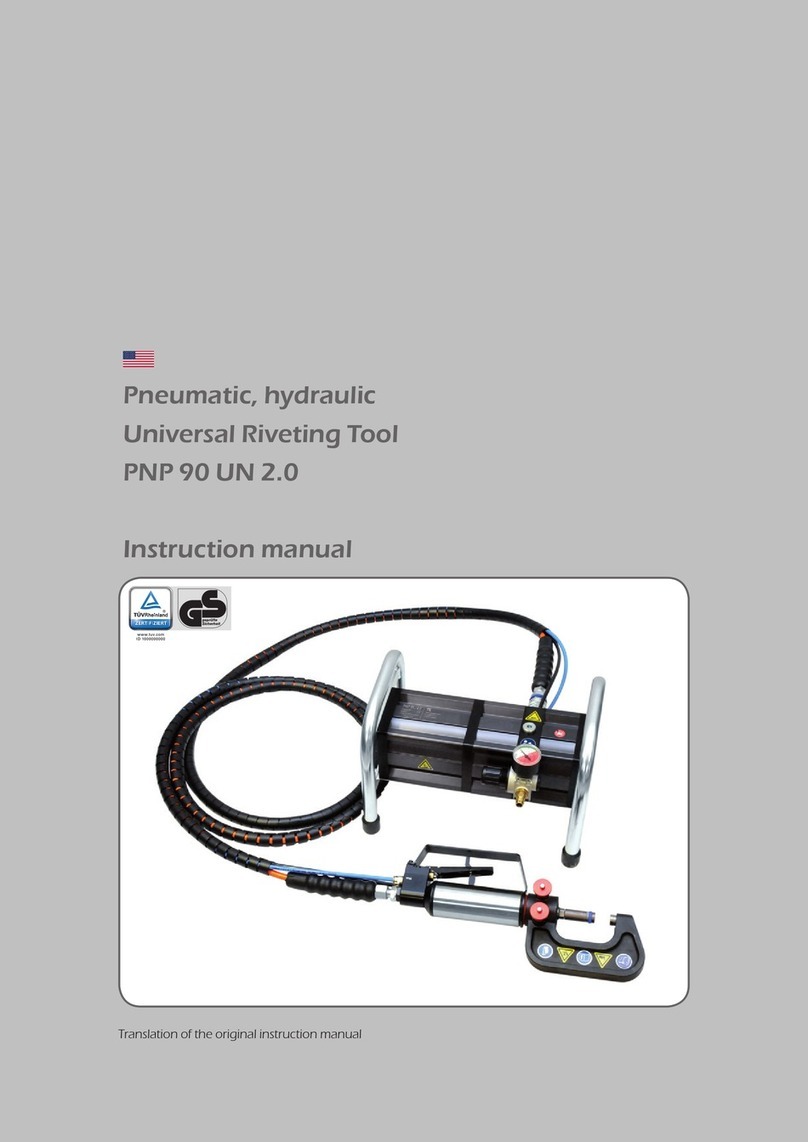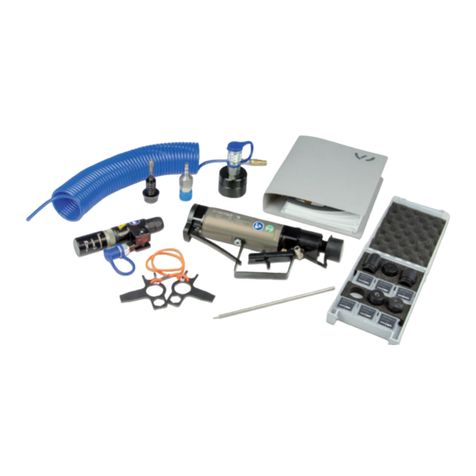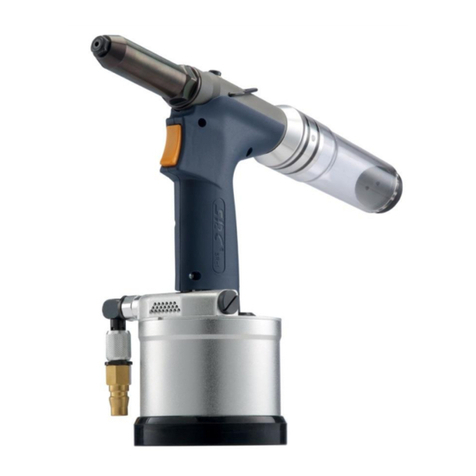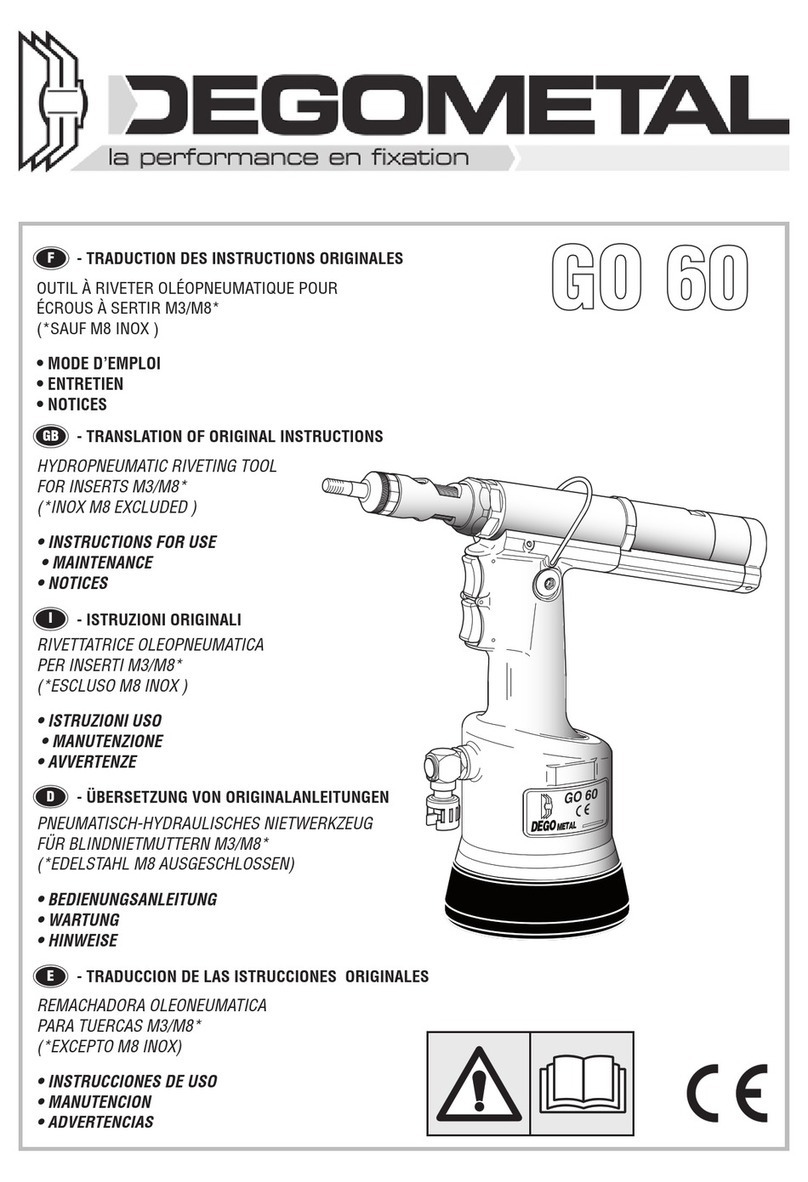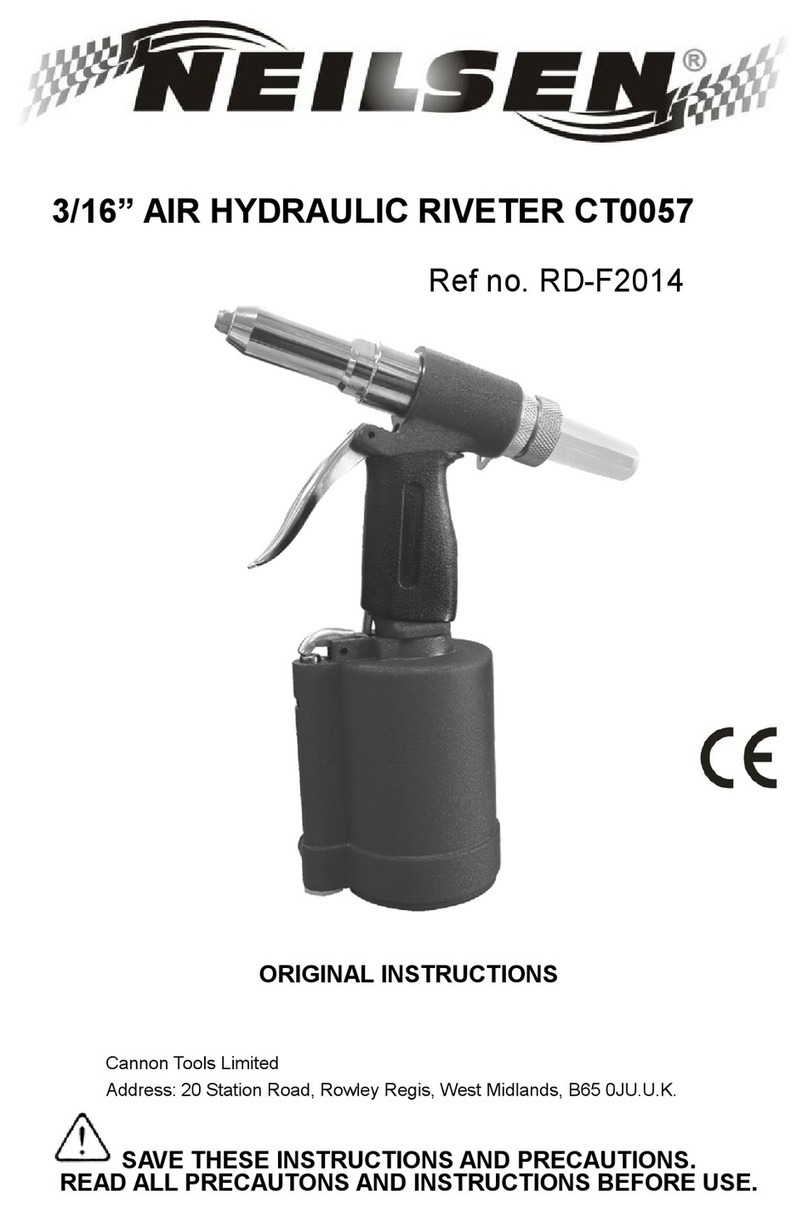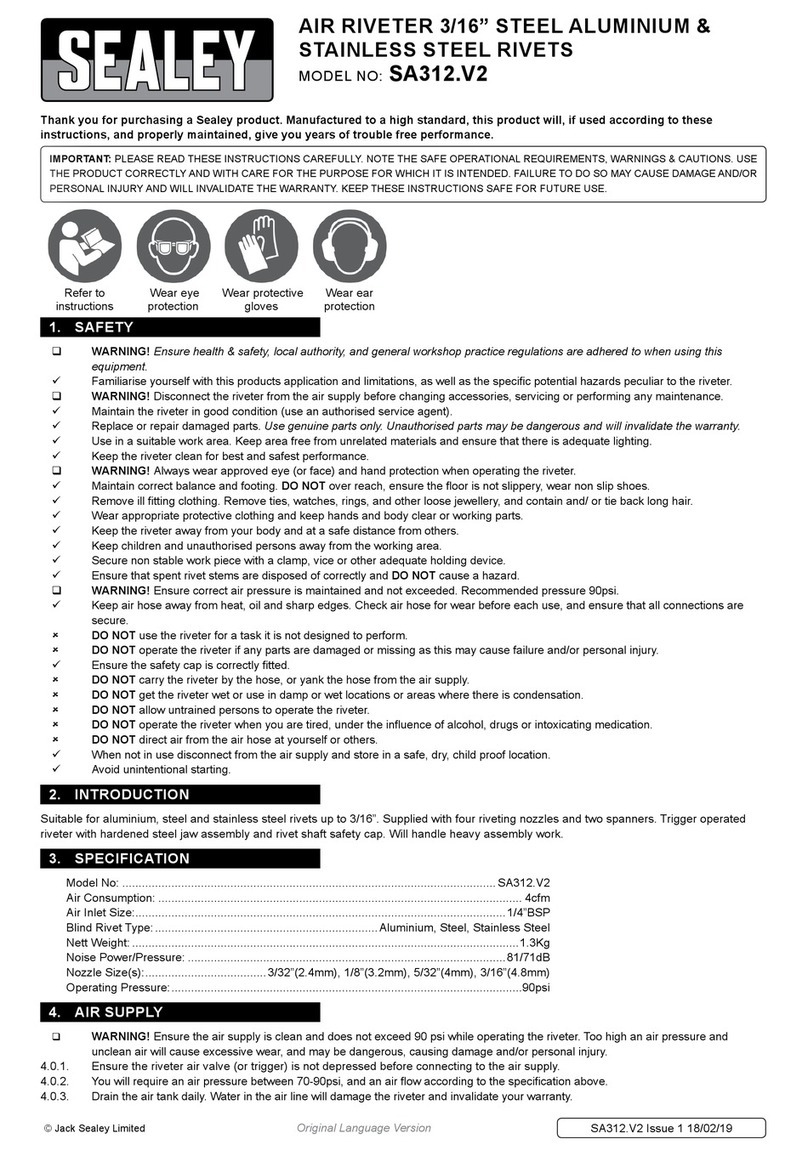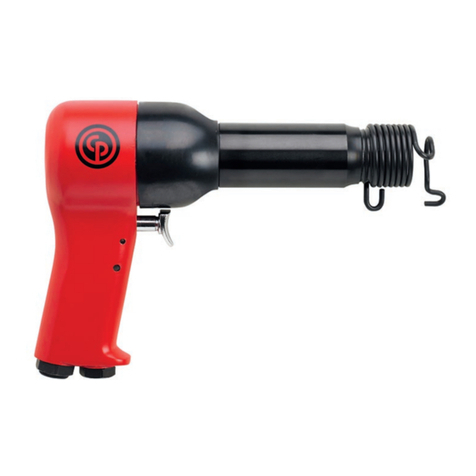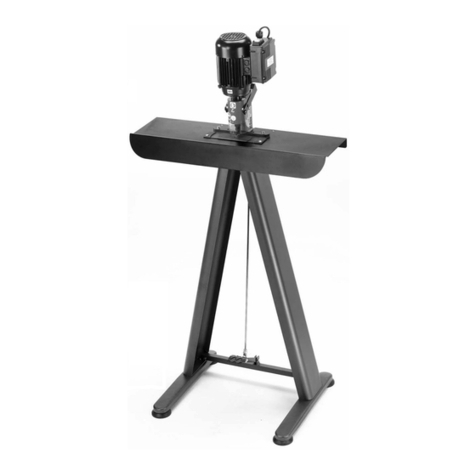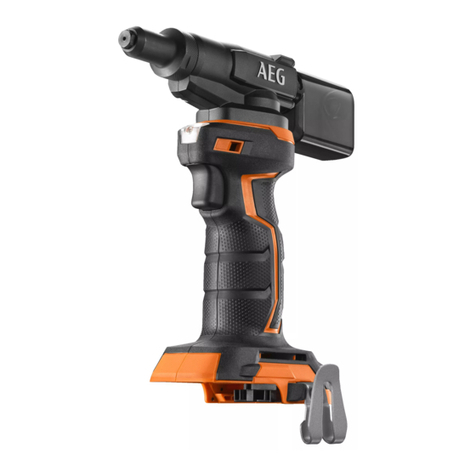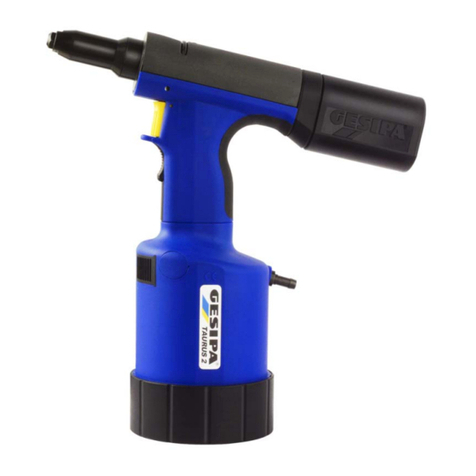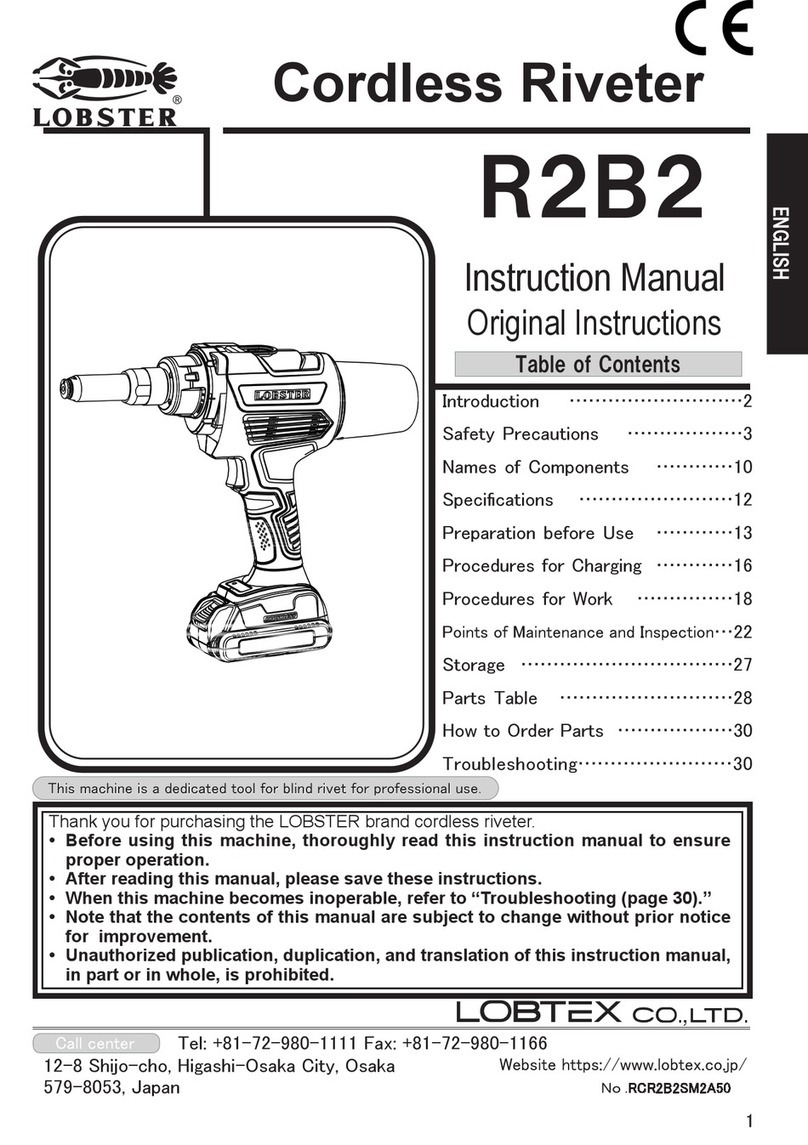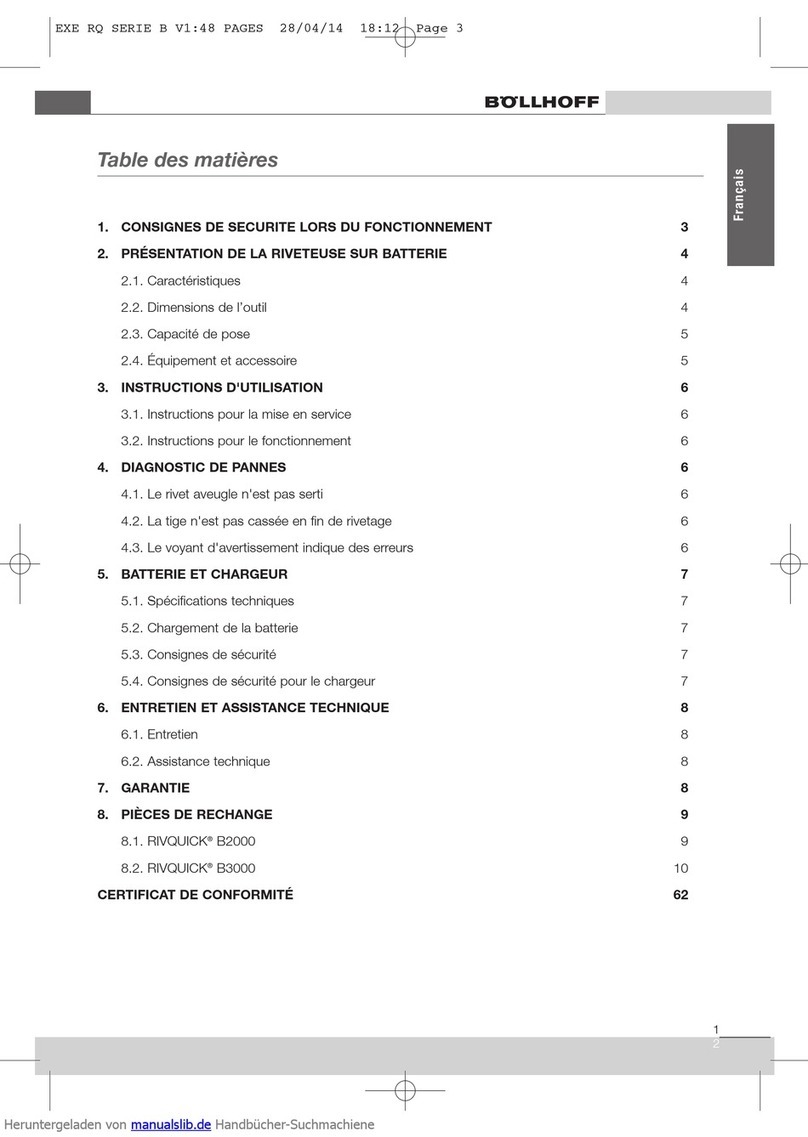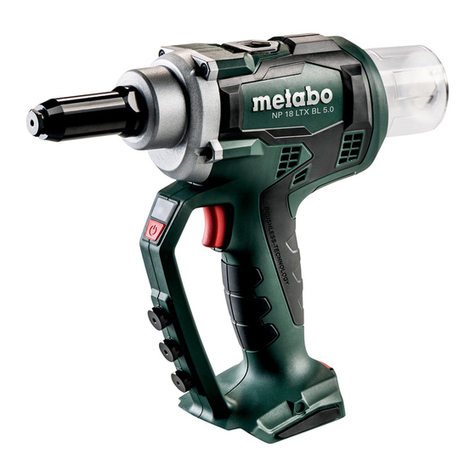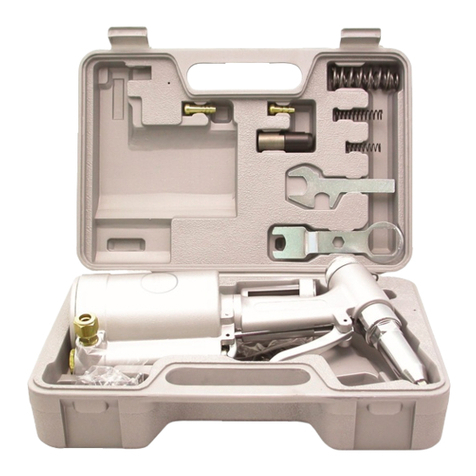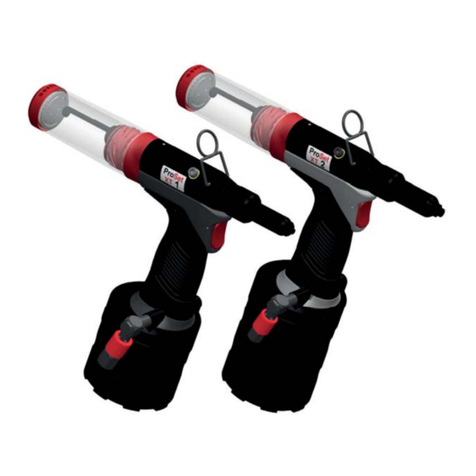TKR Group PNP 90 SNW-RIV User manual

Pneumatic, hydraulic
stamping and riveting tool
PNP 90 SNW-RIV
Instruction manual
83 43 2 158 708, Translation of the original instructions

2
All photos, drawings and other illustrations as well as the text and other content in this instruction
manual are subject to the copyright of both the TKR Group and the author involved. Reproduction,
processing or other use is permitted only with express written consent.

3
1. Information regarding this manual 4
2. Explanation of symbols 5
3. Labelling 6
1. Operating principles 7
2. Accessories and specifications 8
3. Noise and vibration values for PNP 90 SNW-RIV 8
4. Safety instructions 9
5. Fundamentals of riveting tool handling 10
6. Maintenance 11
1. Technical data - pump PNP 90 12
2. Technical data - rivet clamp SNW-RIV 13
1. Initial start-up 14
2. Riveting tool preparation and connection 16
3. Riveting tool operation 22
4. Hydraulic pump maintenance (oil change) 28
5. Riveting tool storage 30
1. Troubleshooting 32
2. Warranty 34
3. Declaration of Conformity 35
Other languages
To obtain this instruction manual in other languages, please visit
our download area on the Internet site:
www.tkr-service.com
1.
2.
3.
4.
5.

4
1.1 Information regarding this manual
Legislation stipulates that workers handling hydraulically-driv-
en riveting tools must be protected.
If desired, training can be provided at TKR in Gevelsberg or on
site at the customer.
In the interests of quality assurance, we reserve the unre-
stricted right to carry out technical modifications on the basis
of further developments in technology and product improve-
ments, without prior notice.
This riveting tool represents state-of-the-art technology. To en-
sure the functionality of the equipment, it must be operated in
a proper and safe manner.
Read the instruction manual carefully before using the riveting
tool.
All handling necessary to ensure correct operation is described
in the instruction manual.
No work method other than that expressly approved by the
manufacturer may be used.
In the event of a fault, the user or owner may only carry out
repair work for faults for which the relevant maintenance pro-
cess is laid out in the instruction manual.
Information
Technical
modifications
State of the
technology
Read the
instruction
manual
Handling
Faults

5
1.2 Explanation of symbols
In this instruction manual, some sections use internationally
known warning symbols, warning symbols and general in-
structional symbols.
The individual symbols are explained below.
Observe the instruction
manual
Observe the general
information
Wear face mask
Wear gloves
Warning
General source of danger
Warning
Hand could become
trapped
Warning
Finger could become
trapped
Warning
Danger of environmental
contamination
Warning
System under pressure
Follow all in-
structions and
safety rules
TÜV certification
Please note the following.
Arrow to clarify
pressing together
Arrow indicating direction
For further information
see chapter...
Audibly engage

A
F
B
C
D
E
1.3.1
1.3 Labelling
AName
BSerial number
CManufacturer’s details, date of manufacture
DMaximum permissible operating pressure (oil)
ECE mark
FSymbol to read the instruction manual
Stamping
and riveting
tool label

7
2.1 Operating principles
The pneumatically driven stamping and riveting tool, model
PNP90 SNW-RIV, is used to install rivets. This tool set is special-
ly designed to rivet sheet metal for the automotive industry.
Each tool set consists of a pneumatically-driven hydraulic pump
as well as the rivet clamp with hydraulic cylinder and the appro-
priate rivet mandrels and dies for the rivets in question.
The hydraulic pump is a pneumatically driven pressure intensifier
with an intensifying ratio of 1:100. This means that hydraulic
pressure is one hundred times the preset air pressure. If the preset
end pressure is reached, the pump automatically stops and
keeps this end pressure constant. The hydraulic pump has a
pneumatically controlled pressure relief valve.
The rivet clamp is connected to the pump with a hydrau-
lic hose. This hose is connected to the pump via a leak-free
quick release coupling. The coupling will only release from the
equipment when it is depressurised.
The two pneumatic control hoses must also be connect-
ed to the pump. Make sure that the black hose is attached
to the coupling that is marked for the black hose. Once the
high-pressure hose and the two control hoses have been con-
nected to the rivet clamp, compressed air can be connected
to the equipment.
The two control valves are installed on the rivet clamp, which
activates pump function. Riveting can only be started when
both valves are actuated. If one of the valves is deactivated,
riveting is interrupted and the rivet plunger automatically re-
tracts.
Never bypass either of the control valves or replace
them with other valves! Without the genuine two-hand
control operation, there is a danger of personal injury.
Pump PNP 90
Rivet clamp
SNW-RIV

8
2.2 Accessories and specifications
In the repair manual from the manufacturer recommended
rivets
Filling capacity 280 ccm
Hydraulic oil brand as per DIN 51524 and
ATF as per DIN 51562-1;
viscosity approx. 68 mm²/s at 40°C
Example: Shell Tellus TX 68, Dexron, Mercon, Hydroclear
6 bar / 87 PSI
Quality class 2 as per ISO 8573-1
5 – 50°C / 41 – 122°F
Protective gloves
Face mask
Emissions noise level: LPAI < 75 dB (A)
Vibration emission value: a < 2,5 m/s²
Permissible
rivet accessories
Permissible
hydraulic oil
Max. air
pressure
Compressed air
Ambient
temperature
Safety
2.3 Noise and vibration values

9
2.4 Safety instructions
Permissible
rivet accesso-
ries
Usage as
described in
instruction
manual
Chapter 4.3
Improper
use
The stamping and riveting tool must only be used for rivet-
ing with the approved accessory tools. Only use genuine rivet
mandrels and dies for the two rivet sizes. Note the information
list on the packaging.
Make sure that the riveting tool is problem-free and that it has
all functionality necessary to ensure safe operation.
The tool must only be used as a hand tool with two-
hand operation! Any modification of the tool or other
usage forms are the responsibility of the user.
Follow all health and safety regulations in the country of oper-
ation. Do not use any hoses or fittings that are not permitted
for the equipment’s operating pressure.
Protective gloves and a face mask must be worn during rivet-
ing as incorrect usage or a tool defect could cause parts to fly,
which could lead to severe bodily injury.
See also ANSI Z87.1-1989
Never wave the tool in the air or allow it to fall.
Never use the stamping and riveting tool for purposes other
than those intended and never allow untrained workers to
use the tool.
The riveting tool must only be used at ambient temperatures
between 5°C and maximum 50°C.
Never use the stamping and riveting tool in areas where there
is a risk of explosion!

10
2.5 Fundamentals of riveting tool handling
Route all supply lines in a manner that prevents people from
tripping over them. Correctly route and attach the compressed
air hose. If a compressed air hose whips around wildly, it could
cause severe bodily injury.
Before starting work, check the preset air pressure! In-
correctly set air pressure could cause equipment dam-
age or bodily injury!
Make sure that the maximum permissible operating air pres-
sure of 6 bar / 87 PSI is never exceeded. Check the setting of
the pressure regulating valve before each riveting operation!
Make sure that the pump is only supplied with clean and dry
compressed air. Moisture and contamination could cause
equipment malfunction and/or damage. Only use com-
pressed air of quality class 2 as per ISO 8573-1.
Always disconnect the riveting tool from pressure when leav-
ing the work site!
The manufacturer accepts no liability for damage or injury
caused by improper repair or use of foreign replacement parts.
Incorrect usage of the riveting tool that leads to equipment
damage invalidates the warranty.
Riveting tool PNP 90 SNW-RIV has been tested and manu-
factured in accordance with European guidelines. The Decla-
ration of Conformity has been included with this instruction
manual.
The compressed air supply must be disconnected from
the equipment before any adjustment or maintenance
work is performed.
Danger of
bodily injury
Max. air
pressure
Clean
compressed air
Warranty
Declaration of
Conformity
Chapter 5.3

11
2.6 Maintenance
Care and
maintenance
Chapter 4.4
The tool’s hydraulic system, pneumatic control systems,
hoses and couplings must all be kept free of dirt and
other contamination. Foreign bodies in the hydraulic
fluid or in the control air will cause the tool system to
malfunction.
All maintenance and service work on the pump must
only be performed with air disconnected and oil
drained.
Normally, pump maintenance only entails a regular oil change
(see 2.2 for permissible oils).
All other necessary maintenance work and/or repairs should
be performed by the manufacturer or properly trained per-
sonnel.
With normal use of the pump, hydraulic oil should be changed
every 80 operating hours or every 6 months. Make sure that
used oil is disposed of as required by national environmental
legislation.
Oil that is not properly disposed of could harm the en-
vironment.
The user must only perform the maintenance and repair
measures outlined in this instruction manual.
Maintenance and repair work not covered in this instruction
manual may only be performed by professionals with proper
training by TKR. For further information on servicing and train-
ing, please contact us at our Service address:
TKR Spezialwerkzeuge GmbH
Service
Am Waldesrand 9–11
D-58285 Gevelsberg (Germany)
Telefon +49 2332 66607-77
Telefax +49 2332 66607-51
E-Mail
support@tkr-service.com

3.1.3
3 .1.1 3.1.2
3.1 Technical Data Pump PNP 90
Length 330 mm
Width 230 mm
Height (incl. handle) 213 mm
Weight 7,665 kg
Max. Input pressure 6 bar
Max. Operating pressure 600 bar

3.2.1 3.2.2
3.2.3
3.2 Technical Data
Rivet clamp SNW-RIV
Length 340 mm
Width 60 mm
Height 275 mm
Clamp opening 78 mm
Opening depth 125 mm
Stroke 25 mm
Press force (6 bar) 55 kN
Weight 5 kg
Length and weight without hoses

4.1.24 .1.1
G1/4“
4.1 Initial start-up
The equipment is delivered from the factory without a com-
pressed air connection. The pressure reducing valve has a con-
nection thread of G1/4“ (internal thread).
The pressure regulating valve is delivered with a cap fitted (Fig.
4.1.1). Remove the cap (Fig. 4.1.2).

4.1.3 4.1.4
R1/4“
Use a compressed air connection with R1/4“ thread and seal
(Fig. 4.1.3). Screw this onto the regulating valve (Fig. 4.1.4).

16
4.2.1
4.2.3 4.2.4
4.2.2
4.2 Riveting tool preparation and connection
Before using the equipment, check the condition of the
riveting tool and the hoses. Risk of severe bodily injury if
the pump or the rivet clamp is damaged.

4.2.64.2.5
In the event of any noticeable damage, the hydrau-
lic components must be replaced. Damaged hoses or
couplings could cause severe injury!
Incorrectly attached hoses could come loose and cause
severe bodily injury.
Check the hoses and couplings for damage.
Connect the high-pressure hose to the high-pressure pump
with the quick release coupling. Make sure that the high-pres-
sure coupling completely engages and locks (Fig. 4.2.4).
Connect the pneumatic hoses. Make sure that the black hose
is attached to the marked coupling (Fig. 4.2.5).
black
blue

18
4.2.9
4.2.7
4.2.10
4.2.8
4.2.11
4.2 Riveting tool preparation and connection
Insert the rivet mandrel and rivet die for
the planned riveting operation in the
rivet clamp and screw them into place
(Fig. 4.2.7 – 4.2.11).
During the entire process, always make
sure that the rivet mandrel and die are
firmly seated.

19
4.2.12 4.2.13
4.2.15 4.2.16
4.2.14
16
13
1 2 3
Make sure that both the correct rivet
mandrel and the correct die are used.
Check for the correct part numbers and
designations (Fig. 4.2.14 / 4.2.15 / 4.2.16).
* These parts are available directly from BMW via your normal parts ordering channels.
Riveting die Ø3, 81 43 2 209 938 B
Rivet bolt Ø3, 81 43 2 209 938 A
Set: 81 43 2 209 938*
Riveting die Ø5, 81 43 2 209 939 B
Rivet bolt Ø5, 81 43 2 209 939 A
Set: 81 43 2 209 939*
Elastomer ring, Wrench set,
06-00000112
BGR-TKR-00000239
Distance bolt, Set: 81 43 2 209 937*
1 = Bushing, 81 43 2 209 937 C
2 = Distance bolt, 81 43 2 209 937 B
3 = Spacer, 81 43 2 209 937 A

20
4.2.184.2.17
4.2 Riveting tool preparation and connection
Never use pressure over the permitted value of 6 bar or
87 PSI. This could cause damage to the equipment or
even bodily injury (Fig. 4.2.17).
Connect compressed air to the pressure regulating valve and
set the pressure (Fig. 4.2.16 / 4.2.17).
max. 6 bar / 87 PSI
Table of contents
Other TKR Group Rivet Tools manuals
